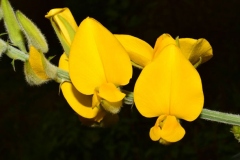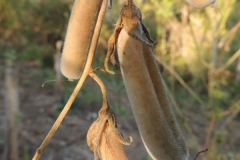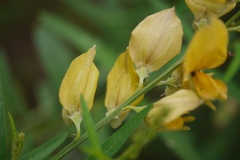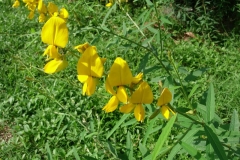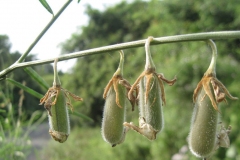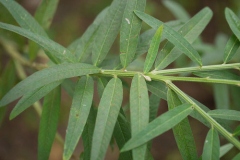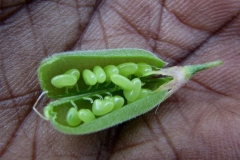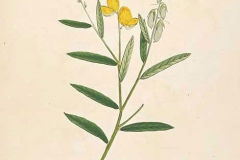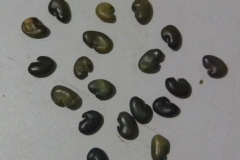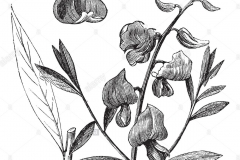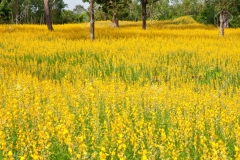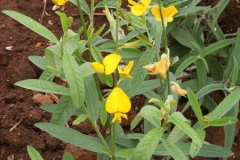The genus name Crotalaria means rattle and is indicative of the noise made by the seeds shaken in the mature pods. The species name juncea was given to this plant by Linnaeus because of its resemblance to Spartium junceaum L., the Spanish broom of the Mediterranean region with its green rush like, scantily-leaved branches. Crotalaria juncea is the fastest growing and most important species of the Crotalaria genus. Sunn hemp is not related to industrial hemp or marijuana. It is actually in the genus Crotalaria but it is not toxic to livestock like Crotalaria spectabilis. The plant is considered as a source of green manure, fodder and lignified fiber obtained from its stem. Sunn hemp is also being looked at as a possible bio-fuel. It can be an invasive weed and has been listed as a noxious weed in some jurisdictions.
Plant Description
Sunn hemp is a multipurpose, short-day, annual, erect shrubby, tropical and subtropical legume that grows about 1 to 4 m tall. The plant is found growing in scrub jungles, dry deciduous forests, and sparse forests and along trails. The plant grows best on fairly light textured soil like sandy loam or loam of at least moderate fertility. It also grows well on clay soils and will tolerate low fertility providing that soils are well-drained. The plant has well developed, long, strong taproot with lateral roots, and much branched and lobed nodules, up to 2.5 cm in length. Stem is up to 2 cm in diameter, cylindrical and ribbed with short appressed hairs.
Leaves
Leaves are simple, about 2.5-10.5 cm long, and 6–20 mm broad, linear or oblong, obtuse or sub-acute, apiculate, pubescent on both sides, hairs appressed and silky. Leaf-stalk is about 1.2-2.5 mm long. Stipules are almost absent.
Flowers are bisexual, zygomorphic, and 5-merous. Calyx is 1.5–2 cm long, covered in short brown hairs with some longer ones interspersed, lobes 3–4 times as long as the tube. Corolla is bright yellow; with elliptical standard faintly reddish marked or tinged wings a little shorter than keel. Keel is 17–22 mm long, with a long, slightly incurved twisted beak; stamens 10, all joined in a sheath open at base. Ovary is superior, 1-celled, style curved and small stigma. Flowering normally takes place from May to September.
Fruits
Fertile flowers are followed by cylindrical hairy pod that is 3-6 cm long and 1-2 cm in diameter, short, velvety hairy and about 6–12-seeded. They are green when young turning to light brown as they matures. Seeds are small flattened, oblique, cordiform, 6-7 mm long, heart-shaped, grayish olive, dark grey or dark brown to black and loosened in the pod at maturity.
Traditional uses and benefits of Sun hemp
- Seeds are believed to purify the blood and are used in the treatment of impetigo and psoriasis.
- It is traditionally used as blood purifier, abortificient, astringent, demulcent, emetic, and purgative, in the treatment of anemia, impetigo, menorrhagia and psoriasis.
- Infusion of bitter leaves are used externally and internally for gastric and bilious fevers accompanied by skin diseases like impetigo and psoriasis.
- It is also used as emmenogogue.
- Root is used for colic and as astringent in epistaxis.
- Seeds used to purify the blood.
- Powdered seeds, mixed with oil are used to make the hair grow.
- In India, it is used for anemia, impetigo, menorrhagia, psoriasis.
Culinary Uses
- Leaves have been recorded as being eaten.
- Flowers are pickled.
- They are also cooked with meat and fish.
Other Facts
- Bark yields fiber used in making twine and cord, canvas and fishing nets, and paper and pulp.
- Fiber possesses properties that make it an excellent choice for papermaking.
- Fibers are mainly suitable for cigarette paper because of the high cellulose and low ash content.
- The strong bast fiber is used primarily for cordage, twine, fishing nets, cigarette paper, tissue paper, bags, sacks, canvas, soles of shoes and sandals.
- Other products include carpets, webbing, table and bed linen.
- With the fibers a potting medium is manufactured.
- Dried stalks and hay are used as forage.
- Sunn hemp is locally used as fodder.
- The number of seeds/kg is highly variable, ranging from 18,000 to 35,000.
- Valuable, high quality, strong fiber is extracted from the stems and bark.
- It is often planted for increasing soil organic matter to over-farmed soils, for loosening subsoil, to reduce soil erosion, conserve soil water and recycle plant nutrients.
- It has also been grown in Brazil and Bangladesh as a soil-improving crop.
- It is also grown to suppress weeds, to prevent soil erosion and to reduce nematode numbers.
- It is a good indicator plant for potassium and calcium deficiencies.
- Seeds are fed to horses in the Soviet Union and to pigs in Zimbabwe.
- Woody stems remaining after fiber removal is used as fuel.
- Seeds are used in the production of an adhesive for plywood and as a coffee-substitute.
Precautions
- Seeds of many Crotalaria species contain toxic pyrrolizidine alkaloids.
- Trichodesmine is the principal toxic alkaloid in Crotalaria juncea.
- Seeds are reported to contain trypsin inhibitors; they are said to be poisonous to cattle, and they can poison both horses and pigs.
- Avoid use during Pregnant and Breast feeding.
References:
https://www.itis.gov/servlet/SingleRpt/SingleRpt?search_topic=TSN&search_value=501804#null
https://davesgarden.com/guides/pf/go/201785/
http://www.hear.org/pier/species/crotalaria_juncea.htm
http://www.theplantlist.org/tpl/record/ild-6022
https://npgsweb.ars-grin.gov/gringlobal/taxonomydetail.aspx?id=12331
https://pfaf.org/user/Plant.aspx?LatinName=Crotalaria+juncea
https://plants.usda.gov/core/profile?symbol=CRJU
https://en.wikipedia.org/wiki/Crotalaria_juncea
https://pdfs.semanticscholar.org/ad27/3ae2f2abc696dd946957b01d87aca4366bdb.pdf
https://indiabiodiversity.org/species/show/229377
https://www.feedipedia.org/node/313
http://www.flowersofindia.net/catalog/slides/Sunn%20Hemp.html
https://gd.eppo.int/taxon/CVTJU
https://www.echocommunity.org/en/resources/808239c5-009a-49f3-8f3a-8a9790836070
https://www.nrcs.usda.gov/Internet/FSE_DOCUMENTS/nrcs142p2_053283.pdf
https://hort.purdue.edu/newcrop/proceedings1996/V3-389.html
https://uses.plantnet-project.org/en/Crotalaria_juncea_(PROTA)
https://www.cabi.org/isc/datasheet/17189
http://www.worldagroforestry.org/treedb/AFTPDFS/Crotalaria_juncea.PDF
Comments
| Sun hemp Quick Facts | |
|---|---|
| Name: | Sun hemp |
| Scientific Name: | Crotalaria juncea |
| Origin | Asia especially Asia tropical (Bangladesh; Bhutan; India) |
| Colors | Green when young turning to light brown as they matures |
| Shapes | Cylindrical hairy pod 3-6 cm long and 1-2 cm in diameter, short, velvety hairy, 6–12-seeded |
| Taste | Bitter |
| Health benefits | Beneficial for anemia, impetigo, menorrhagia, psoriasis, gastric and bilious fevers |
| Name | Sunn hemp |
|---|---|
| Scientific Name | Crotalaria juncea |
| Native | Asia especially Asia tropical (Bangladesh; Bhutan; India). It is now widely cultivated in the drier areas of the tropics and subtropics and in many temperate areas with a hot summer. It is recorded in many countries across the African continent from the Atlantic coast to the Red Sea, from Tunisia to South Africa and in the Indian Ocean islands |
| Common Names | Brown hemp, Bumpo, Ghore sun, Indian hemp, Janumu, Madras hemp, Oohawaimaton, San, Sana, Sanabu, Sanai, Sanal, Sann hemp, Sannai sunn, Sannappu, Saun, Senabina soppu, Shon, Shonpat, Sunn hemp, Tag, Tum-thang, Wuckoo nar, Benares hemp, Bengal hemp, Bombay hemp, Brown hemp, Jubbalpore hemp, Sun hemp, Sann hermp, sunn Crotalaria, Cascavelle, Cocosnut, Grand Sonnette, Grand Tcha-Tcha, Sonnette |
| Name in Other Languages | Arabic: sanjia ( صنجية) , alhasaa albazila( الحصى البازلاء), qunb sanji (قنب صنجي), sanjiat ‘aslia ( صنجية أسلية), Kinab, Crotalaria Assamese: Junjunia-bon, Ā’uca (আঁউচ) aous Bengali: Ghore sun, Shon, Shonpat, Śanapāṭa (শনপাট) Chinese: Tai yang ma (太 陽麻), Shu ma (菽麻), Yin tu ma, Yin du ma, Zi xiao rong Czech : Jutovník tobolkatý English: Benares hemp, Bengal hemp, Bombay hemp, Brown hemp, Indian hemp, Jubbalpore hemp, Madras hemp, San hemp, Sun hemp, Sunn hemp, Sann hermp, sunn Crotalaria, Cascavelle, Cocosnut, Grand Sonnette, Grand Tcha-Tcha, Sonnette Filipino: karay-kagay, putokputukan Finnish: Kuituherne French: Chanvre du Bengale, Crotalaire effilée, Crotalaire jonciforme, Cascavelle, Grand Sonnette, chanvre indien, sonnette, grand sonnette, tcha tcha, grand tcha tcha, Chenvre indien German: Bengalischer Hanf, Bombay Hanf, Ostindischer Hanf, Sanhanf, bengalischer Bombay-Hanf Gujarati: Shan (શણ), shaniyum (શણિયું) Hawaiian: Sannai, Sunn Hindi: Kharif, Krōṭēlērīā (क्रोटेलेरीआ) , Krōṭēlērī’ā jūnasiyā (क्रोटेलेरीआ जूनसिया), San (सन), Sannai sunn, Sannai (सनई), Sunn (सऩ), Madras Hemp, Jhunjhunia (झुनझुनिया), patsan (पटसन), Hungarian: Indiai kender Indonesian: Orok-orok, lembut Italian: Canapa delle Indie, canapa nera Japanese: Kurotararia junsea (クロタラリア・ジュンセ ア), Sanhenpu (サンヘンプ), San henpu (さんへんぷ), Sanma (サン) Kannada: Pundi, senabu (ಸೆಣಬು) Khmer: Kâk’tung Konkani: Sonabu (सोणबु) Korean: Suk ma (숙마) Laotian: Po: th’üang, Thwax chu:b Malay: Orok-orok lembut Malayalam: Kilukiluppa (കിലുകിലുപ്പ), Chanaka, chanam (ചണം) Manipuri: Indian Hemp, Ching Enjhin, Oo Hawai (ঊ হৱাঈ) Marathi: Dhakti ghagri, Ghagharu, San (सन) dhakti ghagari (धाकटी घागरी), Tag (ताग) Nepali: Chhinchhine (छिनछिने), sanai (सनई) Odia: Atasi (ଅତସୀ), shana (ଶଣ) Persian: کروتالاریا , نخود شنی , کنف بنگالی , کروتالاریا جونسئا, San Polish: Krotalaria rózgowata, Konopie indyjskie Portuguese: Cânhamo da India, Cânhamo-de-Bengala, Crotalária, Crotalária júncea, Cascaveleira, Manduvira Punjabi: Sana (ਸਣ), sanni(ਸੱਨੀ) Russian: Krotaliariia sitnikovaia (Кроталярия ситниковая), Krotaliariia indijskaia (Кроталярия индийская), Volokno krotaliarii (Волокно кроталярии) Sanskrit: San, Sana , Śaṇapuṣpī (शणपुष्पी), Sunn, Dhanahari, Dirghapallava (दीर्घपल्लवः), Dirghashakla, atasi (अतसी), shana (शण), samanya shanapatta (सामान्य शणपट्ट) Sinhalese: Hana Slovakian: Bengálske konope Spanish: Cáñamo de la India, Cáñamo san, Cáñamo sunn, Cascabelito Swedish: Sunnhampa Tagalog: Karay-kagay, Putokputukan Tamil : Sanal, Sannappu, Vakkunnar (வாக்குன்னார்), canal (சணல்), catampu (சடம்பு) Telegu: Krōṭalēriyā (క్రోటలేరియా), Shanama, Sunn Hemp, Gilaka, gilaka-chettu (గిలకచెట్టు), shanamu (శణము) Thai: Po thueang (ปอ เทือง), Po tuang Tulu: Talambu (ತಲಂಬು) Urdu: San (سن) Vietnamese: Cây muồng, Lục lạc sợi, Muồng sợi, Suc sat, Luc lac |
| Plant Growth Habit | Multipurpose, short-day, annual, erect shrubby, tropical and subtropical legume |
| Growing Climates | Scrub jungles, Dry deciduous forests, Sparse forests, along trails |
| Soil | Grows best on fairly light textured soil like sandy loam or loam of at least moderate fertility. It also grow well on clay soils and will tolerate low fertility providing that soils are well-drained |
| Plant Size | Up to 1 to 4 m high |
| Root | Well developed, long, strong taproot with lateral roots, and much branched and lobed nodules, up to 2.5 cm in length |
| Stem | Up to 2 cm in diameter, cylindrical and ribbed with short appressed hairs |
| Leaf | Simple, elliptic to oblong, 2.5-10.5 cm long, and 6–20 mm broad, linear or oblong, obtuse or sub-acute, apiculate, pubescent on both sides, hairs appressed, silky |
| Flowering season | May–September |
| Flower | Bisexual, zygomorphic, 5-merous; calyx 1.5–2 cm long, covered in short brown hairs with some longer ones interspersed, lobes 3–4 times as long as the tube |
| Fruit Shape & Size | cylindrical hairy pod 3-6 cm long and 1-2 cm in diameter, short, velvety hairy, 6–12-seeded |
| Fruit Color | Green when young turning to light brown as they matures |
| Seed | Small flattened, oblique, cordiform, 6-7 mm long, heart-shaped, grayish olive, dark grey or dark brown to black and loosened in the pod at maturity |
| Propagation | By Seed |
| Taste | bitter |
| Plant Parts Used | Roots, seeds, leaves and pods |



